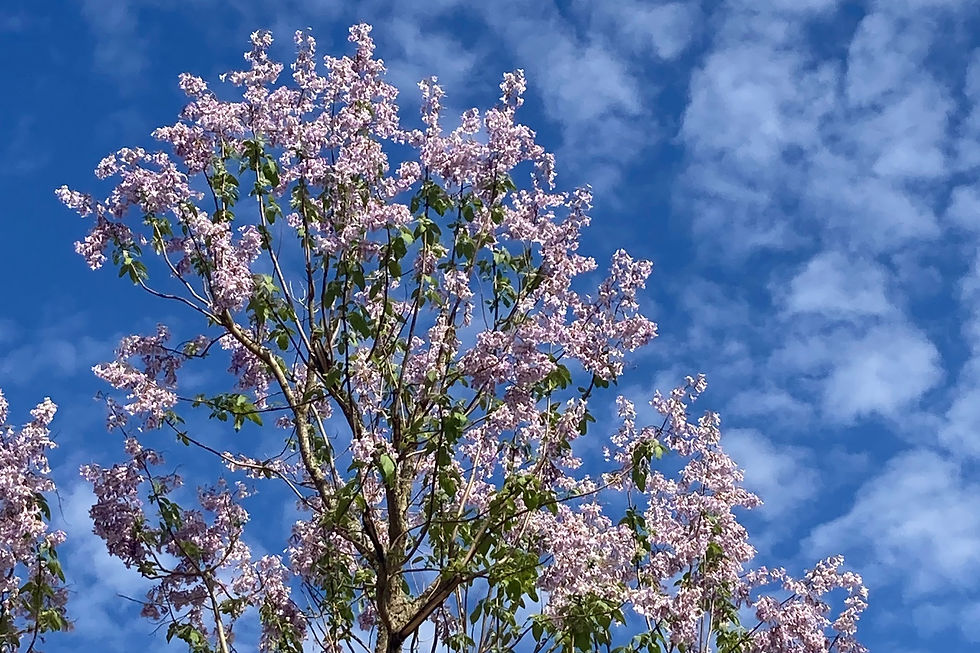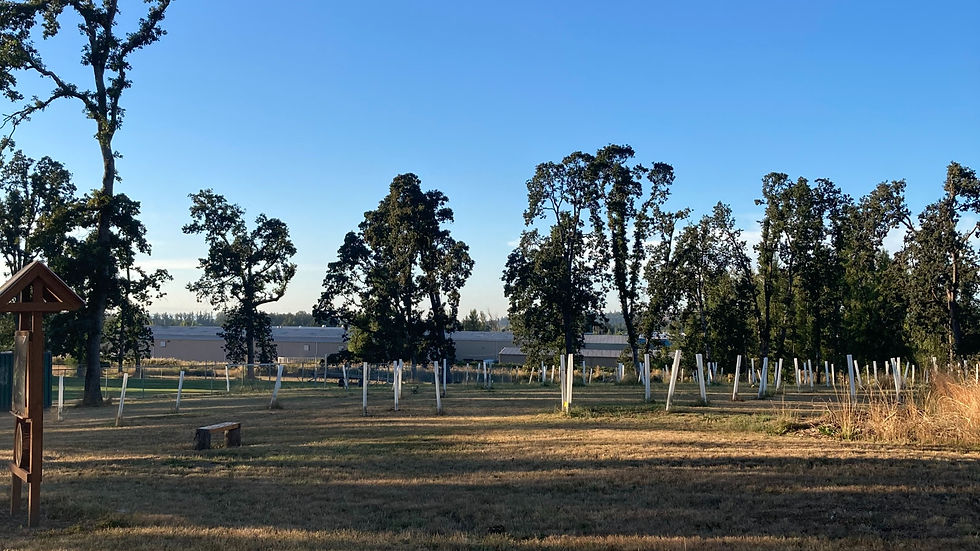Silver Storm: Once-in-A-lifetime Ice Storm Wrecks Trees in “Oregon’s Garden City”
- Becca Owen
- Aug 25, 2022
- 6 min read
Updated: Dec 25, 2022
Each spring, the empress tree growing next to my house glows with purple flowers. A month later, the blooms make way for wide, green leaves that dangle over the roof. When summer temperatures reach the hundreds, the empress tree shades the house during the hottest part of the day. An empress tree is opportunistic and weedy; it grows large and fast without much input.

On the night of February 12th, 2021, I heard a crack, then a whoosh, then a thump as one of its branches broke off and hit the house. I jumped up off the couch. My elderly dog moved out of the living room and into the bedroom, far away from that unnerving sound. We were in the midst of a historic ice storm, and my empress tree, its branches thick with ice, was breaking apart.
Oregon’s Willamette Valley is a verdant agricultural hub for berries, Christmas trees, hops, and hazelnuts. It’s a Mediterranean climate with dry summers and mild, wet winters. Forty miles (70 kilometers) southeast of Portland, nestled against the Cascade foothills, is the town of Silverton. Silverton boasted the late Stu Rasmussen, the first openly transgender mayor in the United States. Another beloved resident was Silverton Bobbie, a dog who got lost on his family’s road trip to Indiana yet somehow made his way home to Oregon several months later.
On Labor Day weekend, 2020, Silverton was in the crosshairs of two out-of-control wildfires. Under an evacuation warning, I packed my dog into my car and fled to a less dangerous part of the state. For weeks, smoke and ash choked the skies. Flames came to the edge of town. Six months later, it felt odd to be under the threat of ice.
Ice storms occur when frozen precipitation hits a warmer pocket of air as it falls towards the earth. The melted precipitation can refreeze upon impact if the ground temperatures are below freezing. This creates a glaze that covers everything with a heavy, slippery coating. Sleet is different from this type of freezing rain: the frozen precipitation refreezes before it hits the ground, but not upon contact with tree branches or powerlines. The US National Weather Service designates an ice storm as an ice accumulation of at least a quarter inch. During the Silverton ice storm, ice accumulated up to an inch and a half over all exposed surfaces.
The recipe for Portland, Oregon-area winter storms is when cold, dry air blows west through the Columbia River Gorge and mixes with the rainy, warm air over the Willamette Valley. This sort of clash can lead to a relatively rare snowstorm where an inch of snow can snarl traffic, cancel school, and cause residents to panic buy groceries. During this particular storm, Portland proper in the northern part of the valley had heavy snow, while the communities in the central region, which included Silverton and Salem, Oregon’s state capital, experienced freezing rain and accumulating ice. Another fifty miles (80 km) south in Eugene, temperatures stayed well above freezing.
All night, loud cracks echoed throughout the still, cold air. The neighbor’s maple was splitting apart, heavy ice-covered branches popping off. Powerlines buckled under the weight of heavy ice, too. “If you’re in the central Willamette Valley tonight,” the meteorologist on the news said, matter-of-factly, “you will lose power.”
An inch and a half of ice weighs down a tree’s branches and can fatally damage its canopy. It can also cause the tree to splinter or even topple under the weight. Eric Hammond, a Silverton resident and certified arborist, knew what was coming when his neighbor’s birch tree began shedding branches during the ice storm. “I knew it was going to break. I know birch trees.” He told his neighbor to move their car before the tree crushed it. The neighbors did so, only to have their car crushed by a different tree. Across the street, a massive Oregon white oak tree ripped out of the ground. An ancient giant, felled.
An array of green and blue flashes lit up the night and my dark living room like high-voltage northern lights—transformers exploded, ensuring we would be without power for days. Even the phone stopped working, as ice-laden trees collapsed onto cell towers.
Oregon white oaks can live up to 500 years and can grow up to 90 feet (27.5 meters) tall. They have thick trunks and massive branches. Silverton was built on the edge of an oak savanna; today, only several groves of these historic trees remain. The city is protective of its signature tree and prohibits residents to cut specimens over 30 inches in diameter without special permission, even on private property. During the ice storm, centuries-old oak trees fared poorly when weighed down with ice. These giants were also responsible for the majority of property damage when they crushed houses and crushed cars.
The same winter storm system that caused ice and snow in the Pacific Northwest also was the culprit for Texas’s deadly cold snap and power crisis. 150 million Americans were under some sort of winter weather alert or warning during that same week in mid-February. The succession of horrors in 2020, shared by millions—from pandemic to ongoing racial injustice and police brutality to a summer full of choking wildfire smoke—created a series of cascading collective traumas, when shared disasters chip away at a community’s mental health. “Trees all over town were crashing and collapsing all night long,” Hammond says. “We were all living through that same trauma.”
The crack from each falling tree reverberated through my house like gunshots. And sure enough, as the meteorologist had declared, the electricity went out. An array of green and blue flashes lit up the night and my dark living room like high-voltage northern lights—transformers exploded, ensuring we would be without power for days. Even the phone stopped working, as ice-laden trees collapsed onto cell towers. There was nothing to do but get into bed and wait for the empress to hit the roof.
The morning after the ice storm, the temperature had warmed enough to free the roads, but the trees were still burdened with ice. My empress had survived the night, though the front lawn was strewn with its limbs. Branches of varying sizes hung from the power lines connecting my house to the street. Up the block, an ornamental ash tree had exploded, its ice-laden canopy split from the trunk and splayed on the sidewalk. Inside, I could see my dog’s breath in the living room.

“If you get stressed out, you can walk over to the shade and sit down,” says Hammond. “If your dog is hot, it can get into the creek. If it’s too smoky in Oregon in late summer and autumn, you can leave. A five-hundred-year-old oak tree—not only is its climate changing, it’s stuck. It can’t move. Its stress will only become more acute.”
Hammond took a survey of Silverton’s trees. He walked over 25 miles (40 km) and cataloged over 3,000 of the city’s trees to survey their damage levels and look for trends in the carnage. Many of the younger Oregon oak trees, those under a hundred years old, did fine. He and others noted that the city had foregone its policy for preserving the ancient trees and had bulldozed a swath of oaks near an elementary school. Rather than having them each assessed and pruned, a call was made to cut them down. I knew these trees well—a shady grove with a gentle slope made a perfect place to take my dog on slow walks.
“If you get stressed out, you can walk over to the shade and sit down. If your dog is hot, it can get into the creek. If it’s too smoky in Oregon in late summer and autumn, you can leave. A five-hundred-year-old oak tree—not only is its climate changing, it’s stuck. It can’t move. Its stress will only become more acute.” -- Eric Hammond, Silverton resident and Certified Arborist
Like other residents, I felt a deep loss when I saw that the trees were gone. But, Hammond says, everyone was reacting to the trauma they had experienced during the ice storm. “We’ve built a town on the edge of an oak savanna and all those old trees are going to die, and there aren’t going to be any new ones unless we plant them ourselves and allow them to grow. That’s part of the story that we need to keep communicating.”
For a few months, I wasn’t sure if my empress tree had survived. But in the late spring, its purple flowers bloomed again. Its large, fan-shaped leaves helped protect the house during the Pacific Northwest’s next deadly weather catastrophe, the heat dome, when temperatures reached 117 degrees Fahrenheit (47.2°C). Later that summer, my old dog passed away in the yard, in the shade of the empress. My new puppy plays with the fallen leaves, throwing them in the air, catching them, and ripping them with her teeth. I realize the empress is too close to my house. I love it, but I see its danger now.

In the year and a half since the ice storm, Hammond spearheaded efforts to replant Oregon white oaks where they had been lost near the elementary school. He is part of an advisory group to help the city make better choices about their trees. He cautions against holding too tightly to aged, vulnerable trees.
“Once a tree is cut down, it’s dead. On this gut level we’re filled with rage,” he says. “But it doesn’t plant a new forest, and that’s what we need to do: plant new trees.”








